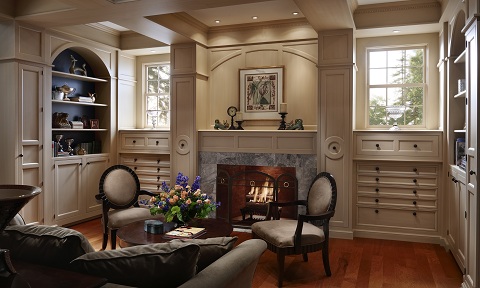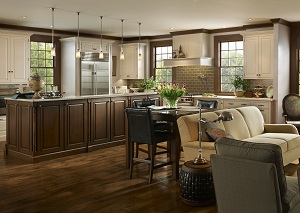
Cabinets are increasingly becoming more simple, yet more high-tech.
Custom Homes | While we’ve all had to adjust in the last few years thanks to the economy, the good news is that the kitchen is still holding its primary importance within the home.
In fact, consumers have been willing to take down walls, combine rooms or steal space from the dining room or home office to make their kitchen a great space for family get-togethers and, often, for multiple work stations that include informal office spaces and various food prep areas.
Cabinetry remains a major functional and architectural consideration in kitchen design. Moreover, the use of cabinetry beyond the kitchen is growing, including installations as entertainment centers, butler pantries, laundry rooms, home offices, bars and even outdoor entertainment or kitchen areas. Another growing cabinet market is in master bath suites. More than just a bath vanity, these can include whole wardrobe storage systems.
In fact, consumers have been willing to take down walls, combine rooms or steal space from the dining room or home office to make their kitchen a great space for family get-togethers and, often, for multiple work stations that include informal office spaces and various food prep areas.
Cabinetry remains a major functional and architectural consideration in kitchen design. Moreover, the use of cabinetry beyond the kitchen is growing, including installations as entertainment centers, butler pantries, laundry rooms, home offices, bars and even outdoor entertainment or kitchen areas. Another growing cabinet market is in master bath suites. More than just a bath vanity, these can include whole wardrobe storage systems.
While the extent of cabinetry within the home has not declined, kitchen and cabinet designs have changed significantly. In the past, dramatic showplace kitchens with elaborate, furniture-quality cabinets were considered the ideal.
Today's home buyers aren't looking for a showplace, postcard look, says Sarah Reep, cabinetry director/designer relations and education for KraftMaid Cabinetry (Masco). Instead, consumers want a kitchen that speaks to them and their image of how they live. They want something contemporary with a great flow. Reep calls this new look “soft modern.”
She adds that over the past 10 or 15 years, a lot of elaborate detail had been added to the kitchen — moldings, corbels, accents. Now, the trend in kitchen design, like in all areas of home design, is cleaning up, architecturally speaking. John Troxell Jr., director of design for Wood-Mode Cabinetry, agrees. “The most significant direction in cabinet design is to a simpler, cleaner, more contemporary look. Not so much the sleek, minimalist look, but certainly more to straight lines — almost a frameless cabinet look.
“You don’t see all the carved details we had six or eight years ago,” he says. “The rustic look is big, too. This means rough-sawn veneers that look as if they were pulled right out of a lumber yard.”
Andy Wells, vice president of product design for MasterBrand Cabinets, Inc., also notes a trend to clean styles and transitional designs. Transitional design has roots in traditional design, but tends to not be as elaborate. It may have an overall traditional look, but the layout is more on contemporary lines in terms of blocks of cabinets, floor-to-ceiling cabinetry or a wall of cabinets. It’s cleaner with less detail and with such elements as flush hardware.
“Transitional styling and modern looks, previously referred to as Euro, are very popular now,” says Wells. “Door styles are becoming simpler, using clean lines and subtle design and we see growth in neutral-finish options, such as natural stains, shades of gray and off-whites.”
Fifty Shades of Gray
Gray is the new hot color. In woods, while maple still has a market, the trend is toward darker, richer, more rustic species, such as birch. “Although white cabinets are still popular, there has been a subtle shift from stark white finishes to gray and creamy neutrals,” says Reep. “Some have even called gray the new beige.
“I don’t know if it has gone that far, but gray tones are definitely seeing wider interest, especially when married with an accent color.”
But, gray can be cold, she adds, so it’s important to use it when matched with a white or lighter shade. It’s often shown with warm-toned floors and gold accent tiles. Matte grey also works well with rustic or industrial designs.
Troxell sees increased demand for off-whites and soft, taupe-like brown colors that play well with white.
As for woods, he says cherry is still one of the major premium woods, but walnut is becoming a bigger factor. Natural-looking materials are also popular, as are distressed finishes. This includes cabinet wood grains and finishes that have an earthy, authentic feel.
The Need for Accents
As kitchens have become more visible within the house and as cabinetry designs have simplified and design lines have become cleaner, the need for color and texture accents has become increasingly important.
 “At one point everything had to match,” says Troxell. “You don’t see that as much anymore. In fact, that concept is really pretty dated. ... This is apparent in cabinet door finishes, with the use of two different-colored painted finishes or a mix of painted and stained finish.”
“At one point everything had to match,” says Troxell. “You don’t see that as much anymore. In fact, that concept is really pretty dated. ... This is apparent in cabinet door finishes, with the use of two different-colored painted finishes or a mix of painted and stained finish.”An example is when wall cabinets are painted and all the others are stained. It’s also seen in the mixing of door styles, where the door design may change from the island to the perimeter cabinets or even where one uses frameless cabinets and the other front frame cabinets, he says.
Generally, upper and lower cabinets will be in the same style family and most manufacturers integrate the styles of their solid and decorative or glass cabinet doors.
Inserts are also common, including painted panels, laminate panels and glass doors with textured, opaque or clear glass. You see accent doors that have aluminum or stainless steel frames or banding, metal panels, inserts covered with reed, grass cloth or fabric embedded in a resin, even leather-covered inserts.
Shining a Light on Functionality
State-of-the-art concepts in cabinet door operation go hand-in-hand with the trend to more contemporary, modern designs.
On the market are cabinet doors that lift up, retract into side pockets, bi-fold or work as full-height tambours like giant appliance garages. There is even some interest in the more radical European concept of cabinet doors that slide on a track from side-to-side across the upper cabinets.
Innovative use of LED lighting is another growingly popular modern option for cabinetry. In addition to conventional under-cabinet and crown molding lighting, cabinet makers are picking up on the European concept of embedding LED lights within pantry or base cabinets or above base cabinet toe kicks.
There is a growing array of specialty cabinets and cabinet interior accessories that run the gambit of price points — soft-close drawers and doors, spice and apothecary drawers and pan and silverware dividers, to name a few.
KraftMaid, says Reep, has nine different concepts for trash management, from pull out drawers to double bins. Omega Cabinetry (Master Brand) offers a remote-controlled locking cabinet. Currently, the most popular cabinet accessories are cabinets that hide small appliances and store bulk food or trash receptacles. - New Home Source
No comments:
Post a Comment